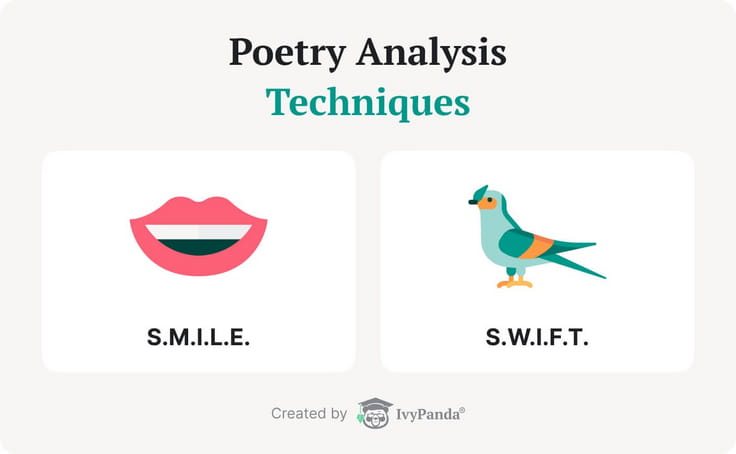Poem Analyzer Online
✏️ Intro to Our Poem Analyzer Tool
By definition, poetry is a type of literature based on the interactions of words, style, and rhythm. If you dive deeper into this genre, you'll discover that it brings the invisible to the forefront and gives a new meaning to the mundane. Admiring it can be one thing but analyzing poetry can turn out to be a daunting task. However, you don’t have to worry—our poem analyzer will quickly uncover all the main aspects of the work you need to evaluate.

Poem Analyzer: Beneficial Reasons to Use
Students always want to make their lives easier and academic work less tedious. And we are here to help you with that! Our poem analyzer tool has several advantages that can help you finish assignments faster and improve your creative writing skills:
📜 What Is a Poem Analysis?
The process of poetry analysis lets students evaluate different aspects of the work and disclose its meaning. It helps people gain a deeper understanding of the poem’s subject, its tone, figures of speech, literary devices, form, and other features. You can also use your paper to describe your feelings about the piece and what the author wanted to say. Additionally, conducting an analysis lets you uncover the deeper meaning behind a poem.
Types of Poetry for Literary Analysis
There are many types of poetry you can analyze with different themes, rhymes, and lengths during your college years. We want to discuss some of the poetry styles you can come across while researching. This segment also explains their differences, which will come in handy in your future analytical paper.
- Acrostic.
Acrostic poems have a lot in common with traditional Japanese works. They use the first letter of each line to spell out a name, word, or phrase. The words they spell out often contain the theme or message of the piece. - Ballad.
This type of poetry was originally accompanied by music and passed down through generations. Ballads often tell dramatic or emotional tales, and their influences can be heard in many modern pop songs. - Free verse.
This type of poetry from 19th-century France prioritizes creative freedom above all else. You can make such poems rhyme or not and use as many words in a verse as you wish. It’s one of the hardest types to analyze, as free verse isn’t based on rules. - Haiku.
This ancient Japanese poetic form doesn’t use the traditional rhyming of Western poetry. Instead, it has only three lines, with the first and third having five syllables and the second having seven. Haiku prioritize content over form and invoke a mood or a feeling from the reader. - Limerick.
Hailing from 19th century England, limericks are comical and sometimes rude poems. The last line often serves as a punchline to a joke. The limerick There once was a Man from Nantucket is one of the most popular examples of the genre. - Ode.
Odes are one of the oldest forms of poetry that date back to Ancient Greece. They are made to praise people and objects. An ode is relatively short in length. - Sonnet.
With its Italian origin, this genre was perfected by Petrarch. It means “little song” and is often composed of 14 lines. As a rule, sonnets are romantic poems with a structure that encourages some level of rule-breaking.
🔎 Popular Techniques of Poem Analysis
We will tell you about two techniques for evaluating poetical writings to make your analysis more comprehensive. They will help you deconstruct and interpret the works.

📚 30 Great Poems for Analysis
- If by Rudyard Kipling.
- Allen Gingsberg’s Howl.
- Still I Rise by Maya Angelou.
- T. S. Eliot’s The Waste Land.
- The Raven by Edgar Allan Poe.
- The Lamb by William Blake.
- William Ernest Henley’s Invictus.
- Victor Hugo’s Tomorrow at Dawn.
- Sonnet 75 by Edmund Spencer.
- John McCrae’s In Flanders Fields.
- John Keats’s Ode to a Nightingale.
- Martin Espada’s Bully.
- The Highwayman by Alfred Noyes.
- Lady Lazarus by Sylvia Plath.
- Adrienne Rich’s Aunt Jennifer’s Tigers.
- Robert Frost’s The Road Not Taken.
- She Walks in Beauty by Lord Byron.
- The Origin of Our People, a Chinese folk poem.
- Sonnet 29 by William Shakespeare.
- Ozymandias by Percy Bysshe Shelley.
- The Addict by Anne Sexton.
- The Divine Comedy by Dante Alighieri.
- A Psalm of Life by Henry Wadsworth Longfellow.
- Ted Hughes’ Life After Death.
- The Red Wheelbarrow by William Carlos Williams.
- Henry Wadsworth Longfellow’s Paul Revere’s Ride.
- Omar Sabbagh’s Vital.
- Dylan Thomas’ Do Not Go Gentle into That Quiet Night.
- The Charge of the Light Brigade by Alfred, Lord Tennyson.
- We Are Many by Pablo Neruda.
Thank you for using our tool! We hope that it managed to help you in your assignment. If your analysis still requires a conclusion, why not try our generator? It can create a suitable ending for your paper in mere seconds!
❓ Poem Analyzer Tool – FAQ
Updated:
🔗 References
- How to Write a Poetry Analysis - Jana Sosnowski, Seattle PI
- List of 168 Poetic Forms for Poets - Robert Lee Brewer, Writer’s Digest
- 10 Essential Types of Poetry - Kayti Lahsaiezadeh, BookBub
- SMILE Approach to Poetry -Sir John Hunt Community Sports College
- Poetry Analysis Collaborative Poster Project for Secondary ELA – The Daring English Teacher
- The 32 Most Iconic Poems in the English Language - Emily Temple, Literary Hub